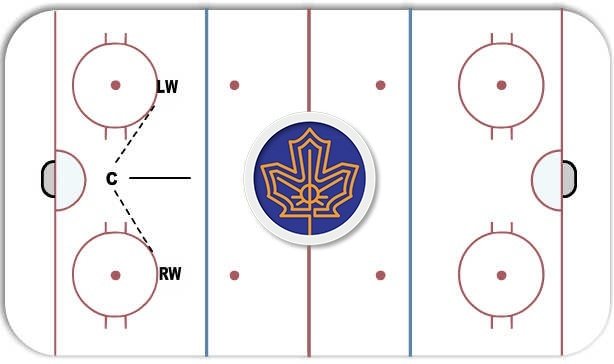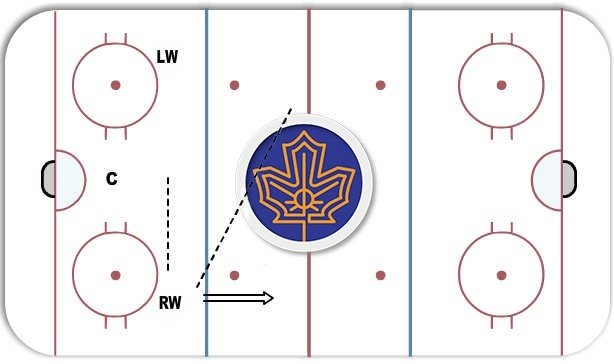When the Toronto Maple Leafs hired Mike Babcock, I went through his systems to paint a picture of what to expect from the team moving forward.
With the turn of the new year and the team almost at the halfway point in terms of games played, this is a good opportunity to further build on the above article.
One of the most significant differences in the Leafs play this season has been their ability to break out up the middle.
When young players are growing up through minor hockey, they all learn a variation of a standard breakout: D-to-D pass, up to the winger, and across to a swinging centre or the far winger who releases wide.
In previous seasons, the Leafs have run similar breakouts while also stretching the zone for long-bomb passes or putting it off the glass and out when in danger. In no particular order, those were their three primary breakouts.
That has changed with Mike Babcock in charge, as the first and ideal breakout option is to hit the centre cutting low up the middle of the ice. There is more risk directing play up the middle, but there is also more reward. An errant play up the wall can be covered up defensively with players retreating to the house or holding their positions, while an errant play up the middle is going to result in a high-percentage scoring opportunity.
This was discussed once by Jason Bourne over at The Score while Babcock was with the Red Wings. Bourne had some video in his post and a quote from Babcock where he talks about breaking out up the middle:
Yeah, for sure, when you think of forechecking in today’s game in the National Hockey League, or any other league, you’re looking to take away the walls. They’re coming hard with one, they’re taking the wall with two, and probably the other side with three, there’s a space that you can execute in front of your net. Obviously the problem is when you turn the puck over in front of your net sometimes it ends up in your net. But I’m a big believer in getting back and executing fast so you don’t have to play in D-zone coverage at all. You turn pucks over by keeping it along the wall and you end up in the D-zone, and we’d like to be in the offensive zone by making that good first pass.
When a breakout is successful up the middle and the centre has the puck between the faceoff dots, the options created for the puck carrier to move the puck up and tilt the ice in your favour are worth the risk. A centre with the puck in the middle of the ice in his own zone has the entire rink at his disposal. He can skate it up the middle or use either of his wingers with short, high-percentage passes:

A winger receiving the puck up the wall does not have all those options readily available to him. Any pass to his winger linemate would have to be a flip pass or long bomb to the far side—hardly high percentage. The winger with the puck can also be angled off along the wall, making skating even to centre ice extremely difficult. A player up the middle of the ice might get stripped of the puck, but he is not going to get angled and closed off along the wall.

You won’t find a team in the league that is not trying to force dump-ins and protect their blueline off the rush. The difference is the ability to break the puck out once that has been been accomplished.
This sequence against the Carolina Hurricanes is a fantastic example. The Leafs lose the draw and immediately pressure not only the puck carrier, but all the loose gaps. The neutral zone step up by Jake Gardiner forces an immediate dump-in. When Phaneuf rushes back to get open and retrieve the puck (an underrated and important part of the play), he is pressured instantly. The wall is covered and he has taken a quick peak to see that before he gets the puck, and the pass is a no looker up the middle to a wide-open Kadri, illustrating the difficulty of centre breakouts—it requires strong timing, communication and trust. From there the exit is simple — Kadri has room, the wingers can release, and he has options.
https://youtu.be/LHEfTu8F1YM
The focus is to avoid rimming the puck around to wingers by funnelling the puck through the middle of the ice at some point. Take the next breakout for instance, where Phaneuf is covered tightly on the D-to-D exchange. He could have whacked at the puck and tried to rim it up to a winger, but he engages Eriksson and chips it lightly off the boards around their battle because he knows Bozak is down low supporting. With one forechecker on Gardiner and another on Phaneuf, when Bozak picks up the puck, the third forward goes in to pressure him as well. This opens up a little time and space for Matthias to get the puck and make a play.
https://youtu.be/rQHY97JN77o
This breakout prospers by taking advantage of one of the Leafs strengths—speed and skill on defense. With Bozak in a defensive position (below the goal line, passing the puck up to a winger), Gardiner joins the rush on the far side, Parenteau cuts in to be the centre, and the Leafs smoothly move out of the zone. It all begins with the centre getting the puck and making the right read; from there, the rest of the players just have to fill their lanes out properly.
Off a defensive zone faceoff win, the centre option is still the primary read for the defenseman. There is a slight wrinkle in this exit, though, compared to the dump-in breakout. When Phaneuf swings around the net with the puck to the far side, Komarov releases the zone to open up space. This is so Kadri has space and options when he gets the pass in the middle of the ice again. In this example, Perron does well enough to stay with Kadri so he can’t skate it in open ice, but that zone release gives Kadri an option up ice. The Leafs ended up retrieving the puck, re-grouping (more on that in a separate post), and getting the puck in the Penguins zone. Not every exit can be glamorous; the key is to avoid exits that result in turnovers or chip outs behind everyone to centre ice, ones that allow the opponent to get the puck right back and shove it down your throat again.
https://youtu.be/TqUcuTxsvq4
Clean exits are a large part of the Leafs being in the middle of the league in terms of overall possession. The key moving forward for the rest of the season and beyond will be mixing in variety on these exits as pre-scouts identify what the Leafs are doing. Teams can either overload one side of the ice (F1 goes to the defenseman, F2 goes to the wall, F3 covers the centre in the middle), or have F2 stay in the middle of the ice, take away the middle option, and angle off the winger should the puck go there (or the defenseman can pinch).
Here is a quick example from the same Bruins game video was taken from above, where the puck swings from d-to-d and Krejci angles Gardiner to go up the wall — clearly not what he was trying to do — which results in a turnover and scoring opportunity against.
https://youtu.be/JGQVwenHmuo
Against Edmonton, Taylor Hall raced to cut off the middle of the ice on a forecheck instead of blocking the short side wall or directly pinning Matt Hunwick along the boards (much more conventional actions) and was rewarded with the puck for doing so.
https://youtu.be/g6jr_2cvsz0
It will be important for the Leafs moving forward to not only be crisp with their low centre swinging exits, but to keep teams honest by activating their defense, and to continue working on their timing up the middle. Some ugly mistakes are going to happen; the Leafs will live with those because they know more good than bad will be the ultimate result.
In just about half a season under Babcock, the Leafs have taken significant strides toward exiting out of their zone not only cleaner but in a position where they can then take the puck down the ice and tilt play in their favour.

































![Craig Berube Post Game, Blues 5 vs. Leafs 1: “We gave them three goals… The [3-1] goal was lazy hockey” Craig Berube, Toronto Maple Leafs head coach](https://mapleleafshotstove.com/wp-content/uploads/2024/10/berube-craig-lak-pg-100x70.jpg)
